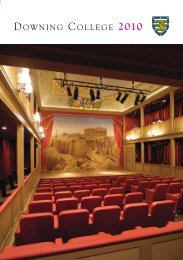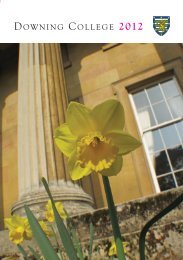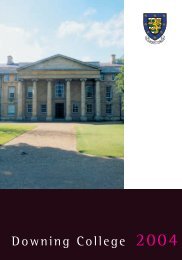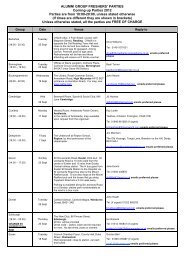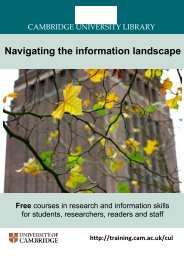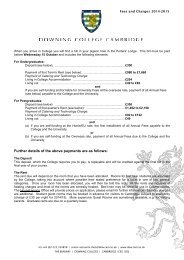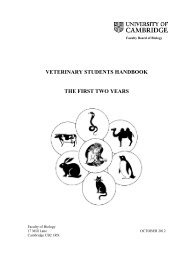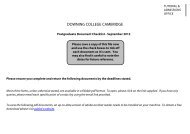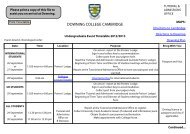2. T. Hope, Observations on the Plans and Elevations designed by James Wyatt, architect,for <strong>Downing</strong> <strong>College</strong>, Cambridge; in a letter to Francis Annesley, Esq. M.P. (1804). The<strong>College</strong>’s copy, in fine full burgundy morocco binding, bears the bookplate <strong>of</strong> Hope’sson, Alexander James Beresford Hope (1820–87), and may well have been the author’sown. A gift to the <strong>College</strong> Library by W. L. Cuttle in 1937. [Cuttle 151]3.. Letter by William Frere to Francis Annesley <strong>of</strong> 20th March 18<strong>07</strong>, making suggestionsfor the foundation stone ceremony. Much <strong>of</strong> the initiative seems to have lain withFrere, outlining a divine service with sermon, a meeting in the Senate House and then‘a procession, as it is called in academical language’. [DCPP/ANN/4/5]4. Single-sheet programme for ceremonial to be observed in the laying <strong>of</strong> the foundationstone, 18th May 18<strong>07</strong>. Several such programmes survive, which were presumablyproduced in large numbers for publicity purposes. [DCAR/2/3/1]5. Facsimile <strong>of</strong> the inscribed plate placed on the foundation stone, taken in stereotypemetal (see front cover and caption). [DCAR/2/3/1]6. Full text <strong>of</strong> the Latin oration given at the Senate House on 18th May 18<strong>07</strong> by WilliamFrere, in his own hand. The speech rehearses at length the many merits <strong>of</strong> the new<strong>College</strong>, the first since Sidney Sussex: especially highlighted are the distinctiveness <strong>of</strong>the terms for Fellowships and Pr<strong>of</strong>essorships, the generous provision for stipends, andthe singular nature <strong>of</strong> her architecture in establishing ‘the pure and uncorruptedbeauty <strong>of</strong> the Greek arts in the land <strong>of</strong> Britain’. [DCPP/FRE/1/4/1]7. Unattributed account <strong>of</strong> the events <strong>of</strong> 18th May 18<strong>07</strong>, also probably by Frere. Revealsthat Frere’s speech was given before the procession, departing from the order indicatedin the printed programme. [DCPP/ANN/5]8. Manuscript copy <strong>of</strong> a poem entitled ‘The Metamorphosis <strong>of</strong> <strong>Downing</strong> <strong>College</strong>’, writtenat the time <strong>of</strong> the laying <strong>of</strong> the foundation stone. Of some wit, the poem muses onthe transformation <strong>of</strong> Sir George <strong>Downing</strong> into a <strong>College</strong>, and may be the work <strong>of</strong>William Meeke or Samuel Grove. Donated to the Archives in 1973 by P. Barnwell.[DCPP/FREN/1/2/11]9. Governing Body Minute Book for the period 1800–7. Leather-bound volume includesfull printed edition <strong>of</strong> the Charter and Statutes, then handwritten summaries <strong>of</strong>proceedings for the years 1800–5, and actual minutes for 1806–7. Early meetings wereheld in London; that <strong>of</strong> 19th May 18<strong>07</strong> took place in the Provost’s Lodge, King’s.[DCGB/M/1/1]10. B. d’Herbelot, Bibliothèque orientale, ou Dictionnaire universel contenant tout ce quifait connoître les peuples de l’Orient, rev edn, 4 vols. (1777–82). First published in Paris,1697. The <strong>College</strong>’s copy bears a French inscription recording the book’s presentationto ‘Francis Annesley, doctor <strong>of</strong> Laws, Master <strong>of</strong> <strong>Downing</strong> <strong>College</strong> ... for the use <strong>of</strong> thestudents <strong>of</strong> that <strong>College</strong>, by his obedient servant Thomas Philipe, London 26thDecember 1809’. Thomas Philipe was a London print dealer with close connections tothe British Museum. This is the only book associated with Annesley’s Mastership, andhas a strong claim to be the earliest surviving acquisition by the <strong>College</strong> Library.[<strong>Downing</strong> 939–942]31
The Schieffelin Leprosy Research & TrainingCentre, Karigiri, Vellore, Tamil Nadu, Indiaby Benjamin DavisAs well as reading Medicine Ben Davis was Senior Organ Scholar. He received agrant from the Association’s Student Support Fund towards the cost <strong>of</strong> hisjourney.Since working with paediatric HIV/AIDS in Kenya last year, my interest in GlobalHealth has been steadily growing and this, combined with a desire to visit India,made the opportunity to visit a hospital in rural Tamil Nadu irresistible. I spent fourweeks in total at Karigiri Hospital, which was originally a leprosarium and then aleprosy research centre set up in the 1950s. With the rapid decrease in the incidence<strong>of</strong> leprosy, the hospital has diversified into a general rural hospital, which continuesto care for many leprosy patients. I chose to spend two weeks with the CommunityHealth Department, and another two weeks in Obstetrics and Gynaecology. Icompleted the Preparing for Patients C part <strong>of</strong> my 2nd MB whilst at the CommunityHealth Department. I was less interested in the clinical medicine than the numeroussupporting activities which provided excellent examples <strong>of</strong> fully integrated socioeconomiccommunity development with a very wide compass. I spent time visitingthe many social development projects in the panchayats (villages) surrounding thehospital. Travelling by motorbike, I was shown many examples <strong>of</strong> fully integratedcare. The department rebuilds houses, provides nutrition to those in need, healtheducation to women’s groups, sets up support groups for those affected byHIV/AIDS, self-help groups for those affected by disability and runs incomegeneration projects – setting up small loans for individuals and communities. Agood example was a 75 year old woman I met, who was cured <strong>of</strong> her leprosy buthad been left severely disfigured. She lived in very poor conditions and her familyhad disowned her and actively avoided her every time she visited the well orapproached them. They lived only a few metres away from her. This had beencontinuing for 30 years. The department highlighted her case and rebuilt her awater-tight house and began health education in her village, including informationon leprosy – how it can and cannot be transmitted. Over time, her family havebegun to accept and support her. Her health has improved massively because <strong>of</strong>better self-care. My time with the department was invaluable in demonstratinghow health and social care must be fully integrated, and how successful it can be.Without adequate social care, patients would continue to present and continue toneed treatment without improvement. I also spent time with a psychologist andpsychiatrist, looking at the psychosocial effects <strong>of</strong> leprosy, particularly the effect<strong>of</strong> depression and emotions on self-care.32
- Page 1 and 2: Downing College 2007
- Page 4: ContentsDowning College Association
- Page 7 and 8: The President. Julian Childs MA
- Page 9 and 10: President’s ForewordThe aim durin
- Page 11 and 12: Cufflinks in solid silver£68 plus
- Page 13 and 14: understanding! The music recitals i
- Page 15 and 16: 14Fellowship and students in reside
- Page 17 and 18: e hung! I was also honoured and del
- Page 19 and 20: Development Director’s ReportThe
- Page 21 and 22: ‘Smaller’ building tasks includ
- Page 23 and 24: 1807: The Laying of the Foundation
- Page 25 and 26: underpinned by shared secular exper
- Page 27 and 28: the digging out of foundations; the
- Page 29 and 30: Earl to give support to his nephew,
- Page 31: and other residents. This is the sc
- Page 35 and 36: proposed the establishment of a Boa
- Page 37 and 38: DIECI PER TAVOLA GRANDE(Ten for Hig
- Page 39 and 40: sailors’ attempts to steer in a s
- Page 41 and 42: Act 5Scene 1: Near MarchThe final A
- Page 43 and 44: The Literary Larrikin (biography) -
- Page 45 and 46: MarriageAndrew Macintosh (2003) mar
- Page 47 and 48: ObituariesStephen Allcock (1952)Ste
- Page 49 and 50: papers and Oral English, examining
- Page 51 and 52: But he hankered after something to
- Page 53 and 54: Claire Louise Cutler, née Morgan,
- Page 55 and 56: John Raynes (1954)We learned from J
- Page 57 and 58: Martin Ward (1957)Martin Ward came
- Page 59 and 60: Editorial acknowledgementsThis publ
- Page 62: Downing College2006 - 200761
- Page 65 and 66: IAN RICHARD JAMES, M.A., M.A. (Warw
- Page 67 and 68: The Wilkins FellowsGODFREY MICHAEL
- Page 69 and 70: James Norman Birch (Fellow Emeritus
- Page 71 and 72: Memorial service for the late Dr St
- Page 73 and 74: 200 Years the Symbiotic Architectur
- Page 75 and 76: 74In contrast, Jefferson was a Pall
- Page 77 and 78: The consequence was that when Jeffe
- Page 79 and 80: In December 2006 Ian Roberts was aw
- Page 81 and 82: Women’s BadmintonThe first team b
- Page 83 and 84:
Semi Final). It was a pleasure to s
- Page 85 and 86:
Music SocietyPresident: Mark Browne
- Page 87 and 88:
competition for the fourth time in
- Page 89 and 90:
Scholarships, prizes and awards 200
- Page 91 and 92:
College prizesArchaeology & Copsey
- Page 93 and 94:
ArchitectureTripos Part IALeung M Y
- Page 95 and 96:
Land Economy Tripos Part IAManji I
- Page 97 and 98:
Natural Sciences Tripos Part IACart
- Page 99 and 100:
Graduate examinationsDiploma in Com
- Page 101 and 102:
LawBailey-Munroe, S JBansal, N KBel
- Page 103 and 104:
Graduate admissions 2006Anglo-Saxon
- Page 105 and 106:
Loizidou, C CLoo, T MMargaronis, S



